
|
Japanese External Reverse Porro Prism Binoculars. On Line MUSEUM |
|
Though it now has major sections of military binoculars (OTHER BINOCULARS sections) and full size binoculars (BIG & SMALL sections) this website was created to document “miniature binoculars”: small reverse porro prism binoculars with form fitting external prism covers , also called “M Type” (Mikron Type), skeleton, mini, vest pocket, micro binoculars, etc. First developed in Germany in 1919, these binoculars were produced in limited numbers in Japan between the wars, produced during/ after the WWII US occupation of Japan, and were widely distributed as a luxury item under a great may brand names. Most of the Japanese contract manufacturers and trading co/ exporters involved were small and went out of business many decades ago. Information about them has been scarce. I have conducted thousands of hours of original research; and documented brands; powers produced; manufacturers, and distribution. This website allows me to share that information. Having “hands-on” experience with over 1,100 of these binoculars, most now have seized oculars due to age hardened optical grease, or prism collimation/ displacement, and other issues. So after repairing around eight hundred +, I created instructions on repairing miniature binoculars to help mechanically inclined optical enthusiasts repair/ restore their miniature binoculars. The nature of the Japanese binoculars industry was that groups of assembling contract manufacturers produced binoculars with parts they made or bought from sub manufacturers, acting under contracts with exporters & trading companies & and foreign importers & distributors & and retailers. With very few exceptions, all of the binoculars brand names you are familiar are distributor or marketing and not manufacturer names. This applies to binoculars branded as Bushnell, Swift, Jason, Tasco, Selsi, Kalimar, Sears, Tower, Milo, Sans & Streiffe, Focal, Frank Nipole, LL Bean, Boots, Imperial, Brookstone, Compass, Empire, Sears, Wards, Scope, Yashica etc. Almost every brand was made by many different manufacturers, and almost every manufacturer marked binoculars with many brands. There are only a few exceptions where manufacturing companies also directly controlled aspects of their own product production, marketing, and distribution (Nikon, Asahi/Pentax, RKK); sometimes with distribution through licensed subsidiary or affiliate importers and distributors. For miniature binoculars I have identified over 32 actual primary assembling manufacturers, though many other companies made small parts. And specific models of specific brands were sometimes made by many multiple manufacturers at different times. Just for example, I have PERSONALLY observed miniature binoculars made by just ONE prolific manufacturer Seiwa Kogaku Ltd./ Seiwa Kōgaku Kōgyō Kabushiki-geisha / 清和光学株式会社 ( mfgr. code JB93 ) to be sold as these brands, and this is just during the period mfgr codes were marked (Updated 3/11/2021). |


|
MFGR. JE CODE ON FRAME (common), (JE50 metal parts manufactured by Tanaka Koki Seisakujo. Inc. |



|
MFGR. CODE ON HINGE COVER (less common placement of marking) J-B231/manufacturer Tochihara Optical Co |
|
MFGR. CODES “HIDDEN” ON INTERIOR PORTION OF PRISM COVER (common) JB74 assembling manufacturer Omori Sogo Kogaku Kogyo, J-E51/ metal parts Yoshimoto Kogaku Co. |
|
Manufacturer Codes on Japanese Binoculars . Hersteller-Codes auf Japanischen Ferngläsern. Codes Fabricant sur Jumelles Japonaises. 日本 の双眼鏡メーカーコード. коды производителей на бинокль из Японии. Tillverkarkoder på Japanes Kikare. Códigos de Fabricante en Prismáticos de Japón. Codici del Costruttore sui Binocoli Giapponesi. |
|
Logos of Japanese Binocular Manufacturers. Logos der Japanischen Ferngläser Hersteller. Logos de Jumelles Japonais Manufacturiers. Логотипы японских биноклей. 日本 の双眼鏡メーカーのロゴ. Logos av Japanska Kikare Tillverkare. Logos van Japanse Verrekijkers Fabrikanten. Logos de Prismáticos Japoneses. Loghi dei Costruttori di Binocoli Giapponesi. |

|
MFGR. CODE “NOT HIDDEN” ON EXTERIOR PORTION OF PRISM COVER (less common placement of marking). J-B69/manufacturer, Akebono Kogaku Kogyo Co |
|
L |
|
J |
|
THE “J-B” above or “JB” mark is actually combined letter JL plus B, as represented above, meaning “Light Machinery of Japan”. |

|
MARK OHNO |
|
There is sometimes a way to know the actual manufacturer, by a stamped or rotary engraved manufacturer’s code, when present, as explained below and shown in the pictures |
|
“ K ” logo trademark of Omori Sogo Kogaku Kogyo |
|
Prior to, during, and after, the JB and JE codes were commonly being marked, one can sometimes determine the manufacturer of some of these binoculars by a stamped logo that contains no wording. In some cases it is easy to know what company these logos indicate. For example, the “ K ” logo of Omori Sogo Kogaku Kogyo on the right is very frequently seen. There are other logos that are not so commonly known or referenced. See our page TRADEMARKED LOGOS for the period applicable trademarks Peter Abrahams documented plus a few others I documented from sources like WIPO and TESS . |
|
According to Peter Abrahams in Outline of Japanese Binocular Production from Nov 1959 and for roughly 30 years disclosure of manufacturer was mandated/ encouraged on optical products, and binoculars, as part of a quality approvals scheme (those oval “passed” stickers by the Japan Binoculars Export Promotion Association). But my experience examining 1,100 +miniature Japanese binoculars suggests the mfgr code marking tapered off in late 1970’s. Mfgr. marking consisted of a combined letter JL (for light machinery of Japan) which in reality looks like J- plus letter B or E, plus a number. So a “J-B” code stamping is for the “assembling manufacturer” of the binoculars, and a “J-E” code stamping is for the manufacturer of the metal frame/body. Binocular collectors refer to these as “JB” and “JE” codes. Around 1955 the Japan Export Binocular Industry Assn imposed production limits (allocations or quotas) as well as price and quality controls on Japanese binocular manufacturers, because of production quantity exceeding demand. According to Abrams, in Aug 1960 the Japan binocular Export Projects Association was created to purchase and export binoculars, but it collapsed in Mar. 1961 with a huge overstock of binoculars, and most of the 203 Japanese binocular manufacturers in operation in 1959 had gone out of business by 1961. Documentation who made what, and what brands were tied to what distributors 40 and 50 years before the internet, had been quite scarce, and to the degree that it existed at all, perhaps not on the internet in English. Some important reference materials in the past had been documented by Bill Beacom, Fred Schwartzman, and Peter Abrahams (see JB JE MFGR. CODE LIST section). |

|
Confusing Names of Japanese Companies Selling Binoculars Verwirrung Namen von Japanischen Firmrn, die Ferngläser Verkaufen. Confondre les Noms des Enterprises Japonaises. Qui Vendent des Jumelles. Смутные имена Вариации японских биноклей компаний. わかりにくい名前日本の双眼鏡のバリエーション企業. Förvirrande Namn på Japanska Företag som Säljer Kikare. Nombres Confusos de las Empresas Japoneses qui Vendieron Prism á ticos. Confuso Nomi di Aziende Giapponesi che hanno Venduto il Bonocolo. |
|
One of the difficulties in discussing and researching Japanese optical (Kōgaku) companies (manufacturers, trading co’s, exporters, purchasing agents, distributors) is that there are multiple variations of each company name: the name using a combination of Chinese derived Japanese characters (kanji) and Japanese characters (kana); the same name using the western alphabet (rōmaji); and then the same name in one or more “translated” forms where words are presented in some loose English equivalent. Additionally there are company name changes over time. Using Riken as an example, in kanji it is 理研光学工業㈱ . In rōmaji and partially abbreviated it is Riken Kōgaku Kōgyō K.K, or unabbreviated is Riken Kōgaku Kōgyō Kabushiki-kaisha (or-Kabushiki-gaisha). In “translated” form it may be Riken Optical Industries Co., Ltd. And then like many other Japanese optical companies, Riken renamed itself and became Ricoh, which in kanji is 株式会社 リコー , and in rōmaji is Kabushiki-kaisha Rikō or Kabushiki-geisha Rikō, and in “translated” form may be Ricoh Optical Industries Co., Ltd, or several other variations. Additionally manufacturers often had an associated controlled “trading “ entity with another name. For example the manufacturing entity Toyo Jitsugi Kōgyō Kabushiki-Kaisha also had the associated Trading entity Oriental Trading Co. “ TJK ” for T oyo J itsugo K K appears on binoculars, but so does “ OTC ” for O riental T rading C o. Oriental Trading Co in acting as a purchasing agent/trading co. might handle binoculars made by other factories in addition to its own manufacturing entity, and Toyo Jitsugo as a manufacturer might sell binoculars through other entities than its own trading co. And while ownership was largely the same, there were some different stockholders. Back to Riken: in discussing Riken any one of nine or more variations of their name might be correct to use in discussing a pair of binoculars that the company produced or handled, or any variation might appear in reference materials you are searching. In addition, an alphabetic company logo or abbreviated acronym might have been used based on any of these variations. In the case of Riken, they used RKK and R.K.K. based on the rōmaji abbreviation of Riken Kōgaku Kōgyō d uring the time that they made these small binoculars. (In general I try to cite the rōmaji names used at the time the binoculars was made). One commonly finds Kōgyō K.K. as a part of the name of these Japanese optical company names. This stands for Kōgyō Kabushiki-Kaisha, (which may also be equally correctly spelled Kabushiki-gaisha), with Kōgyō roughly translated as “industries” and K.K. representing either Kabushiki Kaisha or Kabushiki-gaisha, which may be translated as “industries” and “company, Ltd .”, but may also be translated as “corporation” or “incorporated” or “joint stock co”, but without really being exactly the same business structure as would be for a company using those terms as legally defined ones in the USA. Sometimes Seisakujo is substituted for Kabushika-geisha, and Seisakujo roughly means “factory”, which, as in English, is more of an informal description than any specific legal business structure. It is therefore possible to interpret two Japanese co. name variations as being separate entities when they are not, but is also just as easy to interpret identical or nearly identical entities as being the same when they are unrelated. For example there was a Seiwa Kogaku Co. Ltd (which translates as Seiwa Optical Co Ltd.) that was completely unrelated to another entity called Seiwa Optical, Ltd. And there was an Asahi Kogaku K.K. that made cameras and binoculars (and became very well established and eventually morphed into Pentax) and there also was a completely unrelated entity also named Asahi Kogaku K.K. that made cameras and faded into obscurity, and a third company involved in binoculars names Asahi Kogakuki Co Ltd completely unrelated to the other two. Likewise there were at least four unrelated Japanese binocular manufacturers whose Romanji names spelled out K.O.C. and who were known to have used K.O.C. on markings on binoculars . So what K.O.C. signifies depends entirely on contextual subtlety. And the company associated with miniature binoculars using “ KOC ”, K uroki O ptical C o. is known to have additionally used ‘ KOIC ” for K uroki O ptical I nstrument C o at a slightly different point in the company history. |
|
Miniature Binoculars Model Number. Miniatur-Fernglas Modellnummer. Numéro de Type des Jumelles Miniatures. Номер модели. Miniatyr Kikare Modellnummer. Miniatura Prism á ticos Números de Modelo. |
|
Only a few of these small binoculars display model numbers on the prism covers. Since almost all have serial numbers, the serial numbers are often confused with being model numbers. Model numbers are usually written as “ Model” or “mod” or ”M” then “No.” and then the number. Einige dieser kleinen Ferngläser haben Modellnummer auf den Prismaabdeckungen. Fast alle diese Ferngläser haben Seriennummern. Die Seriennummern werden häufig mit Modellnummer verwechselt. Modellnummer werden geschrieben normalerweise als „Model“ oder „Mod“ oder “M”, dann „No.“ und dann die Zahl. Quelques jumelles affiche des numéros de type sur les couvertures de prisme. Comme presques toutes ont les numéros de séries, les numéros de type sont souvent confondus avec les numéros de serie. Les numéros de types sont souvent prefixe par « Model » ou « Mod », ou « M », avec ou sans « No. ». |
|
Miniature Binoculars Serial Numbers. Miniatur-Fernglas Seriennummer. Numéro de Série des Jumelles Miniatures. Орядковый Номер. Miniatyr Kikare Serienummer. Miniatura Prism á ticos Número de Serie. |
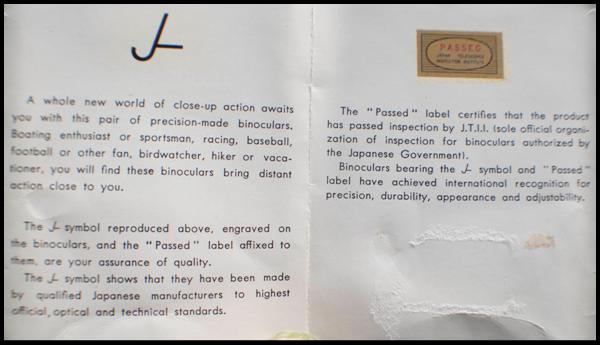
|
“Reverse Porro Prism ”. Rückwärts Poro Prisma. Jumelles Prisme Inverse de Porro. обратная призма. 逆 ポロプリズム. Omvänd Poro Prisma. Omgekeerd Porro Prisma. Prisma de Porro Atrás. Prisma Porro Inverso |
|
Reverse porro prism binoculars arrange the prisms in a configuration so that the image transmission reverses itself twice, allowing a particularly compact design package. Diese Ferngläser haben Prismen, das den Weg des Lichtes zurück auf sich zweimal dreht. Ces jumelles ont des prismes qui renverse le chemin de la lumière deux fois |
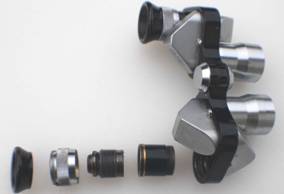


|
In some languages and at various points in times these small binoculars have been referred to in a number of ways. They are often referred to in English as “miniature binoculars”, or as micro or vest pocket or pocket or compact or sub compact or mini or spy or skeleton binoculars, or less correctly as opera glasses (true opera glasses are non prismatic). They may also be referred to as field glasses or theater glasses. German nomenclature is also complicated, and subtleties of meaning today might have been less so in the past. For example, while the German “prismenfernrohr” might accurately today only refer to a prismatic type telescope, in the past Zeiss and others sometimes referred to binoculars that way. These small binoculars may be referred to in German as “Fernglas”, “Ferngläser”, “Opernglas”, “Opergucker”,“Feldstecher”, “Prismenglas”, “Theaterglas”, “Fernrohr”, “Mikrofeldstecher”, “Zwergferngläser”, “Prismenfernrohr” or even “Operngucker Skelettfernglas” or “Mikrofeldstecher”. It makes a Google® search for these in German “challenging”. In Swedish these may be “Miniatyrkikare”, and many languages have various potential sub categories to define these beyond the basic term for “binoculars”. |
|
Ambiguous Nomenclature. Viedeutiges –Nomenklatur. Nomenclature Ambigue. вусмысленным названия компаний. Tvetydig Nomenklaturen. Nomenclatura Ambigua. |

|
Serial numbers on the prism covers. Seriennummer auf der Prismaabdeckung. On trouve les numéros de série sur la couverture du prisme. |
|
Serial number on the frame |
|
Almost all of these small binoculars have serial numbers. On some of the earliest it is on the frame. On post war versions it is normally on a prism cover. Though sometimes confused with model numbers, the serial number is usually longer, and is usually is written as “No.”/ “Nr.” and then the number. Die meisten dieser kleinen Ferngläser haben Seriennummern. Die Seriennummer ist normalerweise auf der Prismaabdeckung. Es wird als „No“/ “Nr.” und dann die Zahl.La plupart de ces petites jumelles ont des numéros de série. Il est normalement sur la couverture de prisme. Cependant parfois confus avec des numéros de type, le numéro de série est plus grandque le nombre de type et est préfixe par « No. / “Nr.”». |
|
Quality Inspection: Binoculars. Qualitäts-Inspektion Fernglas. Inspection de Qualité des Jumelles. Проверка качества.Бинокль. Kvalitesontroll av Kikare. Inspección de la Calidad de Prismáticos. Ispezione di Qualità del Binocolo. |
|
The flyer at right came with one of these binoculars and explains the Japanese “quality” inspection by the JTII (Japan Telescopes Inspection Institute), a quality control organization for optical products being exported from Japan. Various alternative “inspection arrangements” also existed. |
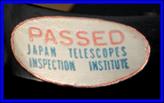

|
Power (Magnification) of Binoculars. Leistung Im Sinne De Ferngläser. Puissance d’optique des Jumelles. оптических измерений мощности на бинокли. Förstoring av Kikare. Potencia óptica de Prismáticos. Ingrandimento del Binocolo. |
|
Most binoculars use a standardized nomenclature to denote power, such as “6x15”. This designates the power and the objective lens diameter in millimeters. So “6x15” is six power using a 15mm objective lens diameter. The power is the magnification, and the larger the number then the greater the magnification. The objective lens is the last lens on the binocular furthest from the eyepiece. Size of this affects the light gathering ability of the binocular, and is also used in designing the field of view of the binocular. |
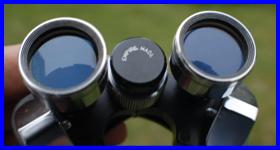

|
Objective lens diameter |
|
Field of View of Binoculars. Sichtfeld Fernglässer. Champ de Vision des Jumelles. Поле зрения бинокль. Synfält Kikare. Campo de Visión Prismáticos. Campo di Vista del Binocolo. |
|
Field of view is how much the binocular can see right to left, expressed as an angle, or alternately expressed as how many feet right to left can be seen at 100 yards. The photos below illustrate the difference between an Asahi made Bushnell 6x25 (‘wide angle”) binocular and an Asahi made Bushnell 6x15 binocular. Same power (6x), same manufacturer, but different lenses and prisms, and quite a different result in the image produced. (Photos are a simulation of the binocular view) |

|
Photo of Land Rovers I dragged out of the weeds and rebuilt myself for my collection, less a diesel that wouldn’t start on this day, less a Range Rover one I wore out, less a military Lightweight in pieces, and excluding an armored military Snatch Land Rover and Disco 1 I acquired after.) Photo by Jim Leach. with wide angle lens Also the approximate view one sees using the Bushnell 6x25 wide angle binoculars at 150 feet, which has a comparatively wide field of view. |




|
Same magnification. Same brand. Different objective lenses. Different prisms. Different geometry. Different field of view. |
|
This is the approximate view through the Bushnell 6x15 binoculars at the same 150 feet. Lots less Land Rover trucks now (and not even from those electrical Lucas Prince of Darkness issues). So, comparatively a narrow field of view. |
|
Binoculars or Opera (Theater) Glasses ? Fernglässer Oder Opernglässer? Jumelles ou Jumelles Theater? Kikare Eller Teater Glasögon ? Prismáticos o Lentes de Teatro? Binocoli o Occhiala da Teatro? |
|
There is often confusion about what is properly an “ opera glass ” and “ theater glass ”, versus a small (prism) binocular . There is a specific difference that is based on the type of lens configuration and lens arrangement. Opera glasses and theater glasses use Galilean optics. That is to say they use a concave eyepiece lens and a convex objective lens mounted in-line to produce an inexpensive and simple low power magnified image by direct transmission, but which is correctly oriented due to the combination of lenses. They do not use prisms. The eyepiece (ocular lens) is in line with the last (objective) lens. The performance is inferior to prism binoculars, and the magnification normally low. The small binoculars on this website use four porro prisms (triangular prisms that each shift the image path 180 degrees) to create a correctly oriented image, plus magnification lenses. The image path reverses itself twice, and these binoculars are poro prism binoculars , and to be more technical, are reverse porro prism binoculars. This configuration of prism arrangement gives a quite compact configuration as the objective lens housings are inboard in relation to the ocular (eyepiece) lens assembly and does not increase the width of the binoculars, as is the case with standard poro prism binoculars. |





|
Opera glasses |
|
Reverse Porro Prism Binoculars |



|
Prism Glass: BaK4 and BK7 . Glasmaterial BaK4 und BK7. Jumelles Prismes BaK4 et BK7. Стекло формул, h используемых на призм: BaK4 и BK7. Prism Glas: BaK4 och BK7.Cristal Las Fórmulas Utilizadas en los Prismas: BaK4 y BK7. |
|
One sometimes encounters the binocular prism designations BaK4 and BK7. These originally were designations created by Schott AG for it’s optical glass products. BaK stands for Ba ritleich K ron or Barium Crown glass. Schott AG Bak4 is a specifically defined glass: # 569561 glass with a refractive index of 1. 569 and an Abbé number of 56.1 , which indicates how much it will disperse light into its component colors. And Schott AG BK7 indicates the use of borosilicate flint glass. But because these are products and designations of a private company, and not a publicly defined or enforced defined standard, Bak4 marked optical glass made be phosphate crown glass. In theory Bak4 has a high refractive index, and will pass more light on the edges of the field of vision. But because of hype and promotional misuse of the designation by optical distributors, and because quality and performance are the totality of a great many factors rather than just the glass, these designations as used in the general consumer market may mean little or nothing as a prediction of the actual performance or quality of a pair of binoculars. BaK4 ist hochwertiges glasmaterial aus Bariun-Kronglas. BK7 ist glassorte aus Bor-Kronglas mit guten transmissionseigenschaften. Bak4 Vidrio es Bario Vidrio. Bk7 Vidrio es Borosilicato Vidrio Flint. |
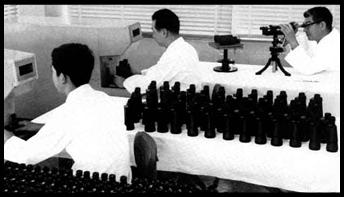
|
JTII (Japan Telescope Inspection Institute at work inspecting binoculars, in the 1950’s. |


|
Die Geschichte betreffend Miniaturferngläser in Japan. L'histoire des jumelles miniatures au Japon De geschiedenis van piepkleine verrekijker in Japan 日本 の小型双眼鏡の履歴 Historien om miniature kikkert i Japan La historia de Japón los prismáticos en miniatura История в отношении японского миниатюрного бинокль Η ιστορία των μικροσκοπικών κιάλια στην Ιαπωνία. Historie ohledně japonských miniaturní dalekohled La storia in miniatura binocolo in Giappone. |
|
Manufacturers Omori Sogo, Meiji Seiko, Tokuhiro, Akebono, Tochihara, & Tanaka also produced huge numbers of miniature binoculars in different brand names. The interplay of manufacturers, brands, models, & distribution makes these little binoculars interesting, and they are also practical precision prismatic binoculars that work quite well (when in a good state of repair) in the same form as when invented 99 years ago. |
|
Asanuma Aurora Belfont Belvedere Berkeley Scientific Binolux Bueno Capitol Carton Compass Cornell Cosmica Daylite Eagle |
|
Ednar Elite Empire Frank Nipole Gold Crest Gold Cup Golden Gate GreenKat Harpers Healing Herters Hi Score HK Ideal Horizon |
|
Hoya Humburg Imperial Iveco Jana Jason Kalimar Karl Stein King Limer Look Marine Mayflower Mt Fuji |
|
Nipole Nishline Norlux Olympia Olympic Optex Orion Pallas Petlux Phoenix Pollux Raiya Raleigh Remington |
|
Saraha Savoy Scope Sears Selsi Seiwa Simor SNK Sparrow Stein SUI Suprima Super Zenith Tasco |
|
This prism arrangement gives a visually correct image, rather than an upside down or mirrored image. |
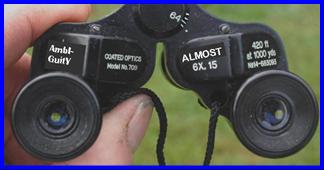



|
+ |
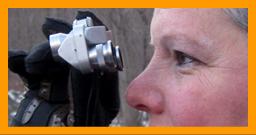
|
Telesar Tosari Tower United Vista Vixen Wuest Yamatar Yashica Yokosho Zenith Zykkor
|

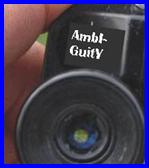
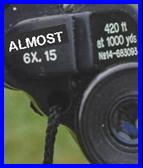

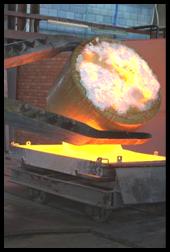
|
Precision optical glass production process Photo credit: Lytkarinsky Optical Glass Factory |
|
The following list is of manufacturers I have observed to have been involved in the manufacture of the many various brands of these Japanese (miniature) External Reverse Porro Prism Binoculars, ( updated JULY 20,2021 ) either as the assembling manufacturer of record (JB number), or as the parts manufacturer of record (JE number), or as an identified subcontracting manufacturer or manufacturing distributor. And excluding middlemen who did not actually make anything such as purchasing agents and exporters, though the lines could blur as some manufacturers had affiliated exporters that they owned outright, partially, or had common ownership elements. Most of the best known “big names” in Japanese binoculars (Bushnell, Swift etc.) were importers and distributors who contracted to have binoculars made for them. Likewise, and adding to the confusion, if was quite common for a manufacturer who also exported and or distributed under their name, to contract to have a portion of their product line made for them, or purchase existing models branded to them to round out their product line. Please note that some manufacturing efforts in the 1950’s and 1960s were essentially consortium group efforts so that there were almost certainly many other manufacturers in addition to the assembling and/ or parts manufacturer of record. So the list should be regarded as accurate but incomplete. Where possible the companies are listed in their “translated” form, and in rōmaji, and in Kanji (see the section “ Understanding the Name Variations ” on the page ” INTRODUCTION ” for a complete explanation). Addresses, where available, are normally from a 1959 list of binocular makers published by the Japan Binoculars Export Promotion Co and made available by Peter Abrahams at: http://home.europa.com/~telscope/j-list.txt Be aware that if a company had more than one location at the time, then this address is probably a sales office address, rather than a factory address, but it could be either.
Akebono Optical Co., Ltd. (Akebono Kōgyō Seisakujo) ( 曙光学工業 ) : 1-956 Nogata-cho, Nakano-ku, Tokyo Asahi Optical Co.Ltd. ( Asahi Kōgaku Kōgyō Kabushiki-geisha) ( 旭光学工業株式会社 ) 980 Shimura-maeno-cho, Itabashi-ku, Tokyo Asanuma & Co Ltd Carton Optical Industries Ltd ( カートン光学株式会社) Fuji Photo Optical Co,. Ltd. : 1-24 Uetake-cho, Omiya-Shi, Saitama Furukawa Kōgaku Seisakujo ( 古川光学製作所 ) Hoya Optical Co, Ltd. (Hoya Kōgaku Kōgyō Kabushiki-geisha) ( 保谷光学株式会社 ) 38 Oyama-Kanai-cho, Itabashi-ku, Tokyo, Japan Hyoshi Optical Co. Ltd. 2-30, Chihaya-cho, Toshima-ku, Tokyo, Japan Ibuki Kōgaku Co. Ltd. ( 伊吹光学株式会社 ) Iikura Optical Works (Iikura Kogaku Seisakujo Inc.) ( 飯倉光学製作所 ) : 43 Tokumaru-cho, Itabashi-ku, Tokyo, Japan Kamakura Optical 2-51-2 Shimo-machi, Kita-ku, Tokyo Kuroki Kogaku Kogyo Co, Ltd. 1088, Shimura-Maeno-cho, Itabashi-ku, Tokyo Meiji Seiko Co, Ltd. ( 明治精工株式会社 ) : 803 Yukigaya-cho, Ota-ku, Tokyo, JapanNikkei Optical Co.( 日経光学株式会社 ) Nippon Kogaku Kogyo Co.Ltd. (Nippon Kōgaku Kōgyō Kabushiki-geisha) ( 日本工学株式会社 )Oi-Morimae-cho, Shingawa-ku, Tokyo Oei Kōgaku Co Ltd. ( 応永光学株式会社 ) Ofuna Optical Instrument Co., Ltd (Ofuna Kōgaku K.K.)( 大船光学工業株式会社 ) 659 Dai, Kamakura-shi, Kanagawa Oji Optical Machine Co. Ltd (Oji Kōgaku Kikai K.K.)( 王子光学機械株式会社 ) 5-34 Inatsuke-Nishi-machi, Kita-ku, Tokyo Okaya Optical Co, Ltd (Okaya Kōgaku Kikai K.K.) 岡谷光学機械㈱ , ( Vista brand binoculars) Omiya Kōgaku Kikai Seisakujo ( 大宮光学機械製作所 ) Omori Sogo Kōgaku Kōgyō Ltd. ( 大森総合光学工業 ) : 202 Ikegami-Honcho, Ota-Ku, Tokyo Oshimoto Kōgaku Co Ltd Otake Optical Co (Otake Kōgaku Kōgyō Kabushiki-geisha( 大竹光学工業株式会社 ) 2-242, Kita-machi, Nerima-ku, Tokyo Pentax Corporation (Pentakkusu Kabushiki-geisha )( ペンタックス株式会社, ) Rikken Optical Co., Ltd. (Riken Kōgaku Kōgyō K.K.) ( 理研光学工業㈱ ) Sankyo Optical Co Ltd. (Sankyo Kōgaku Kōgyō Kabushiki-geisha) ( 三共光学工業株式会社 ) : 2-8 Naka-Jujo, Kita-ku, Tokyo Siewa Optical Co. Ltd. (Seiwa Kōgaku Kōgyō Kabushiki-geisha ) ( 清和光学株式会社 ) : 5-1617 Naka-machi, Nerima-ku, Tokyo Tanaka Optical Co Ltd (Tanaka Koki Seisakujo) ( 田中光機製作所 ) 4 Fujimi-cho, Itabashi-ku, Tokyo Toa Optical Co., Ltd. (Toa Kōgaku Kōgyō Kabushiki-geisha )( 東亜光学株式会社 ): 1-7 Chihaya-cho, Toshima-ku, Tokyo Tochihara Optical Co ( 栃原光学株式会社) Tokuhiro Micro Binocular Co : (Tokuhiro Koki Seisakusho Inc)( 徳弘光機製作所株式会社 )9-1101 Nippori-machi, Arakawa-ku, Tokyo Ueta Seiki Co. Ltd Yashica Co Ltd ( Yashica Kōgyō Kabushiki-geisha ) ( ㈱ ヤシカ ) plus U.S. subsidiary marketing firm Yashica Inc. Yoshimoto Optical Co Ltd. : ( 吉本光学株式会社 ) 1-3340 Nishi-Sugamo, Toshima-ku, Tokyo Zuiho Optical Instrument Co Ltd. ( Zuihō Kōgaku Seiki K.K., Tokyo )( 瑞宝光学精機工業株式会社 ) 3-7 Kyobashi, Chuo-ku, Tokyo
|
|
Japanese Companies Involved in the Manufacture of Miniature Binoculars. 小 さな日本双眼鏡生産する企業 . Japanische Firmen die Miniaturferngläser Herstellten. Sociétés Japonaises Qui Ont Fait les Jumelles Miniatures. Японские компании, вовлеченные в производство миниатюрных бинокль. Las Empresas Japonesas Involucradas en la Producción de los Prismáticos en Miniatura. Aziende Giapponeisi Coinvolte Nelia Pruduzione de Binocoli Miniatura. |
|
What Are Miniature External Reverse Porro Prism Binoculars? Was sind Miniatur-externe Porro-Prismen-Ferngläser?Quels sont les jumelles miniatures externes de prisme de prisme inversé? ミニチュア外部逆ポロプリズム双眼鏡とは何ですか? Vad är Miniature Extern Reverse Porro Prisma Kikare?Wat zijn miniatuur externe omgekeerde Porro Prism-verrekijkers?¿Qué son los prismáticos de prisma de Porro reverso externo en miniatura?Che cosa sono i binocoli con prismi a porro rovesciati esterni miniaturizzati? |
|
They are compact porro prism binoculars with the prisms “reverse” positioned so that the objective lenses and barrels are closer together than the oculars (eyepieces) to make them more compact than standard prorro prism binoculars designs, and with the prisms in 4 separate “external” prism covers rather than being mounted internally within a single piece housing or body. Binoculars are generally classified by presence or absence of prisms, and how they are arranged, as shown below. Sie sind kompakte Porro - Prismen - Ferngläser, deren Prismen "reverse" so positioniert sind, dass die Objektivlinsen und - trommeln näher beieinander liegen als die Okulare (Okulare), um sie kompakter als herkömmliche Proroprismenferngläser zu machen, und die Prismen in 4 separaten "externen" "Prismenabdeckungen, anstatt dass sie intern in einem Gehäuse oder Gehäuse aus einem Stück montiert sind. Ferngläser werden im Allgemeinen durch das Vorhandensein von Prismen klassifiziert und wie sie angeordnet sind, wie unten gezeigt. Ce sont des jumelles prismatiques compactes avec les prismes "inversés" positionnés de telle sorte que les lentilles et les objectifs sont plus rapprochés que les oculaires (oculaires) pour les rendre plus compacts que les modèles proro prismatiques standard, et avec les prismes dans 4 "Le prisme recouvre plutôt que d'être monté intérieurement à l'intérieur d'un boîtier ou d'un corps monobloc. Les jumelles sont généralement classées en fonction de l'absence de prismes et de leur disposition, comme indiqué ci-dessous |
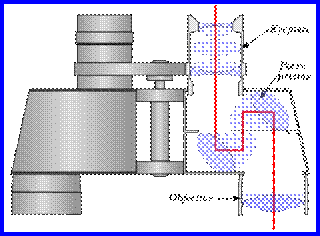
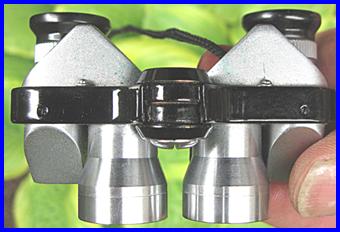

|
STANDARD PORRO PRISM BINOCULARS (outward objective lenses) |
|
MINIATURE REVERSE PORRO PRISM BINOCULARS (inward objective lenses) |

|
Serial Numbers on Miniature Binoculars. Seriennummern auf Miniatur–Fergläsern. Numeros de Série Sur des Jumelles Miniatures. Серийные номера на миниатюрных биноклях ミニチュア双眼鏡のシリアル番号. Serienummer På Minikikare. N ύ meros de Series en Prismatáticos Miniatura. Numeri Seriali sul Binocolo in Miniatura. |
|
Serial numbers can be useful in suggesting where in a production run a particular pair of binoculars falls, or when changes in designs occurred relative to each other. But they can also be potentially misleading. Serial numbers can be assigned from number one for each brand, or for each individual model, or for everything the company made, or could be assigned as a specific block for a particular model. As a result, serial number 20,213 could actually represent binocular #213 produced of a type assigned a serial number block starting at 20,000. That would mean that serial number 20,213 did not really represent 20,213 of anything having been made as it might appear, but 213 of something made. Observation of other earlier serial numbers would be necessary for an accurate assessment. For example we know that some of the Baumann binoculars (Fata Morgana 6x, Optistar 6x) worked that way, but the Fata Morgana 4x presumably started at serial #1. That type systems means numbers in between blocks might never have been actually placed on a product. Serial numbers could be assigned to represent an actual manufacturer’s number, regardless of the various brand contracts that a manufacturer might produce, or else could be assigned from #1 for each brand contracted by the manufacturer with an importer or exporter. With low numbers or with a serial number spread of examples of identical binoculars to examine, a good educated guess might be possible as to how the serial numbers were used. Additionally, manufacturers sometimes start preproduction prototypes at serial number 1, but others start their production numbering at an artificially higher number, to counter the widespread [and sometimes correct] public perception that early production runs of anything don’t really have the bugs worked out. So it is probably risky to make quick definitive assumptions based on serial numbers, absent a few examples to give a better idea of how the numbers were being used . |




|
BINOCULARS RESEARCH WEBSITE, NOT FOR PROFIT FERNGLAS-FORSCHUNGS-WEBSITE, NICHT GEWINNORIENTIERT SITE DE RECHERCHE SUR LES JUMELLES, SANS BUT NON LUCRATIF |



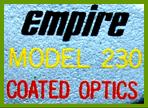


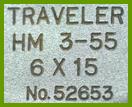



|
Model No AND Serial number |

![Text Box: CLICK ON PAGE LINE. CLIQUEZ SUR LA LIGNE DE PAGE. KLICKEN SIE AUF SEITENZEILE. HAGA CLIC EN LÍNEA DE PÁGINA..[ページ行]をクリックします。НАЖМИТЕ НА СТРОКУ СТРАНИЦЫ. ALSO SEE INDEX.](image6052.gif)



|
GENERAL WEBSITE UDATE December 19, 2025 AS OF 12/19/2025 37,511,479 VIEW S OF WEBSITE |